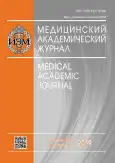РОЛЬ СИМПАТИЧЕСКОЙ И ПАРАСИМПАТИЧЕСКОЙ ИННЕРВАЦИИ В НЕЙРОИММУНЫХ ВЗАИМОДЕЙСТВИЯХ В ЭНДОМЕТРИИ ПРИ НАРУЖНОМ ГИНЕТАЛЬНОМ ЭНДОМЕТРИОЗЕ
- Авторы: Андреев АЕ1,2, Дробинцева АО1,2, Полякова ВО1,3
-
Учреждения:
- ФГБНУ «НИИ акушерства, гинекологии и репродуктологии им. Д.О. Отта»
- ФГБОУ ВО «Санкт-Петербургский государственный педиатрический медицинский университет»
- Санкт-Петербургский государственный университет
- Выпуск: Том 19, № 1S (2019)
- Страницы: 56-58
- Раздел: Статьи
- Статья опубликована: 15.12.2019
- URL: https://journals.eco-vector.com/MAJ/article/view/19323
- ID: 19323
Цитировать
Полный текст
Аннотация
В настоящий момент актуально исследование роли периферической нервной системы в контроле воспалительных процессов при эндометриоидной болезни и ее вовлечение в развитии хронического болевого синдрома при данной патологии. Целью настоящей работы была оценка взаимного расположения симпатических и парасимпатических нервных волокон при наружном генитальном эндометриозе (НГЭ) на различных стадиях прогрессии. Образцами для исследования послужили биопсии эндометрия пациенток, репродуктивного возраста, c НГЭ на I-IV стадии заболевания, имеющих первичное бесплодие (n = 20). Группу контроля составили 3 пациентки (n = 5) не имеющие никаких признаков эндометриоза. Визуализация молекулярных маркеров производилась с применением иммуногоистохимического метода. В качестве первичных антител использовались антитела к тирозингидроксилазе (TH, 1 : 200, Abcam, США) и PGP 9.5 (PGP 9.5, 1 : 1000, Abcam, США). В качестве вторичных антител применялись Alexa Fluor 488 (1 : 1000, Abcam, США) и Alexa Fluor 647 (1 : 1000, Abcam). Визуализация результатов производилась на конфокальном микроскопе (FluoView 1000 (Olympus)). Для оценки взаимного расположения исследуемых маркеров применялся режим 3D-съемки. В результате проведенной работы было установлено, что экспрессия обоих исследуемых маркеров выявлена во всех образцах. Полученные данные могут значительно увеличить понимание механизмов функционирования процессов неонейрогенеза в эктопической и эутопической ткани, позволив тем самым повысить точность методов диагностики эндометриоза.
Ключевые слова
Полный текст
Об авторах
А Е Андреев
ФГБНУ «НИИ акушерства, гинекологии и репродуктологии им. Д.О. Отта»; ФГБОУ ВО «Санкт-Петербургский государственный педиатрический медицинский университет»
А О Дробинцева
ФГБНУ «НИИ акушерства, гинекологии и репродуктологии им. Д.О. Отта»; ФГБОУ ВО «Санкт-Петербургский государственный педиатрический медицинский университет»
В О Полякова
ФГБНУ «НИИ акушерства, гинекологии и репродуктологии им. Д.О. Отта»; Санкт-Петербургский государственный университет
Список литературы
- Министерство здравоохранения Российской Федерации, Департамент мониторинга, анализа и стратегического развития здравоохранения, ФГБУ «Центральный научно-исследовательский институт организации и информатизации здравоохранения» Минздрава: Заболеваемость взрослого населения России в 2016 году // Статистические материалы. Часть II. - М., 2016.
- Ярмолинская М.И., Айламазян Э.К. Генитальный эндометриоз. Различные грани проблемы. - СПб.: Эко-Вектор, 2017. - 615 с.
- Адамян Л.В. и др. Эндометриоз: диагностика, лечение и реабилитация. Федеральные клинические рекомендации для ведения больных. - М., 2013. - 65 с.
- Tokushige N, Markham R, Russell P, Fraser IS. Nerve fibres in peritoneal endometriosis. Hum Reprod. 2006;21(11):3001-3007.
- Miller EJ, Fraser IS. The importance of pelvic nerve fibers in endometriosis. Womens Health (Lond). 2015;11(5):611-618.
- Патент РФ №RU2657787C1. 15.06.2018. Иммуногистохимический способ выявления симпатических и парасимпатических структур на гистологических препаратах // Патент России RU2657787C1. 2018 / Inventor Е.И. Чумасов, Д.Э. Коржевский, Е.С. Петрова.
Дополнительные файлы







